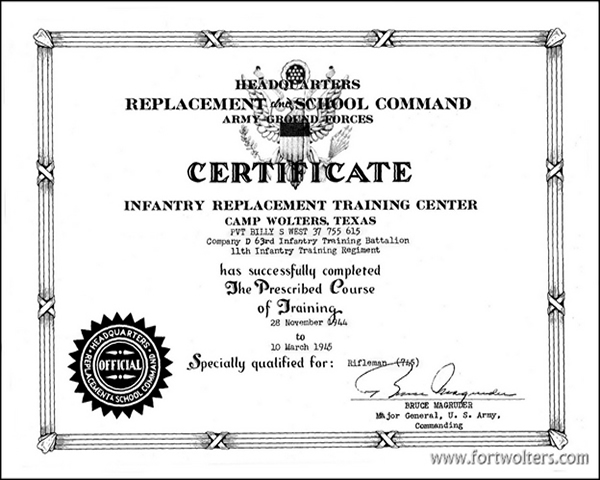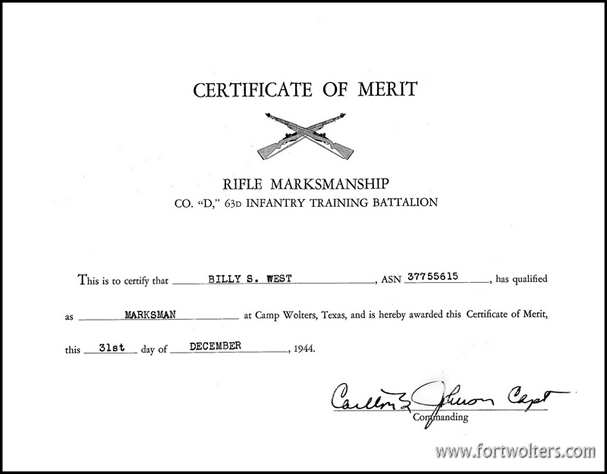
- Home
- Camp Wolters
- A Model Soldier
- Camera Trip Through Camp Wolters
- Camp Wolters Longhorn
- Camp Wolters Ephemera
- Camp Wolters Guide
- Camp Wolters IRTC
- Camp Wolters Postcards
- Camp Wolters Unit Photos
- Christmas Menu
- Present Site of Camp
- Southwestern Bell Booklet
- Camp Wolters Souvenir Book
- IRTC Doughboy
- Soldier - Billy S. West
- Soldier Artist
- Soldier's Letters
- Soldier's Photos
- Fort Wolters
- United States Primary Helicopter/School
- Flight Training
- ORWAC Class 68-24
- WORWAC Class 67-5
- Training Aircraft
- Stagefields and Heliports
- Southern Airways of Texas
- USAPHS Commandants
- Battery D, 4th Missile BN 562nd Arty
- 328th U.S. Army Band
- Det. 20, 16th Weather Squadron
- Guide and Directory
- Crash Rescue Map
- Dave Rittman Photos
- Fort Wolters Photo Gallery
- Fort Wolters Ephemera
- Wolters Air Force Base
- Fort Wolters Main Gate
- Around Mineral Wells
- Texas Forts Trail
- Vietnam
- Sitemap
- Links
- About the Site
- What's New
This page is dedicated to S/Sgt Billy S. West from Joplin, Missouri, who was representative of the more than 200,000 Infantrymen who trained at Camp Wolters in WWII. Billy ended up with 84th Infantry Division, 333rd Regiment in the European Theatre of Operations (ETO). Billy saw action in the last weeks of the war but told his son, "the Germans were falling back so fast they couldn't catch them most of the time." The pictures below are iconic and clearly show the equipment that Infantrymen used during the war. From the Camp's opening for training in 1941 until the end of the war, its graduates went out fully prepared to fight the Axis forces all over the world. They succeeded with bravery and skill and earned the sobriquet of "the Greatest Generation." Note: All of the material on this page was kindly donated by Dan West, the son of Billy S. West, from the personal family records of his father. After the war, and as a Staff Sergeant, Billy Sherman West was discharged and returned to civilian life. He celebrated his 90th Birthday in August, 2016. Thank you Billy for your service to our country!! |
|
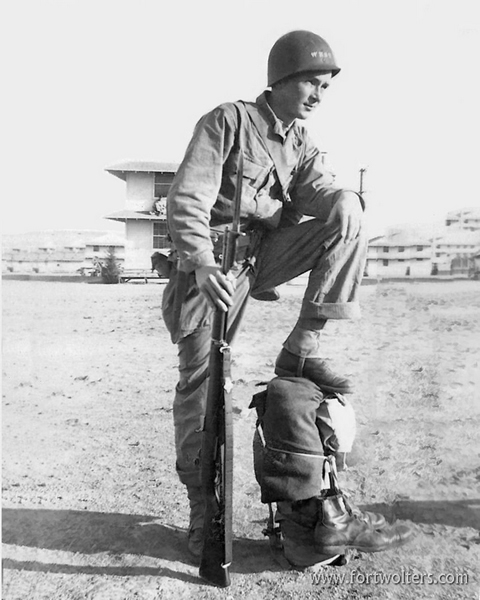 |
S/Sgt Billy S. West as a trainee at Camp Wolters in 1944. His foot is resting on his pack with a spare set of boots attached. In his right hand he is holding his M1 Garand rifle upon which he has mounted a 16" M1905 bayonet. The M1 began to be slowly issued to Riflemen in September 1937, and production increased quickly when the war started so that by the end of 1941 the Army was fully equipped. General George S. Patton called it "the greatest implement of battle ever devised." It was a semi-automatic weapon which conferred a great advantage over the slower bolt-action rifles that the Axis forces generally used. The M1905 bayonet was original designed early in the century and was used in WW1. There were 1,540,578 bayonets produced between April 1942 and May, 1943 by six different civilian firms. They supplemented 581,00 similar bayonets that had been stored after WW1. |
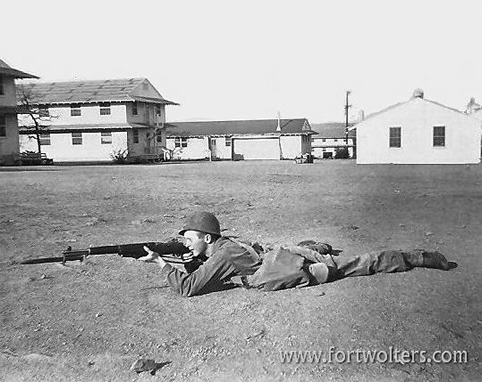 |
S/Sgt Billy S. West demonstrating the prone firing position in company area at Camp Wolters. |
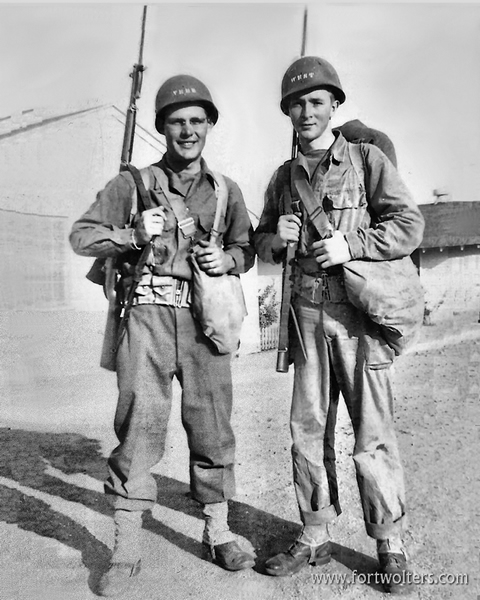 |
S/Sgt Billy S. West with an unidentified friend in the company area at Camp Wolters in 1944. |
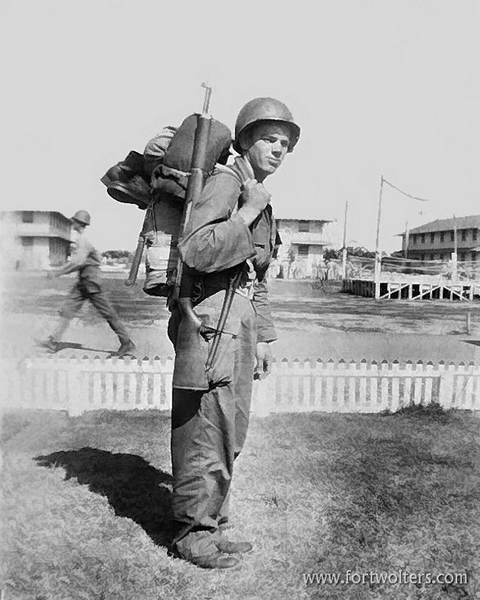 |
This is a photograph of Ora L. Millard, who is Dan West's Uncle. Ora went through Camp Wolters in early 1944 and saw quite a bit of action with the 35th Infantry Division in the ETO. |
S/SGT Billy S. West, Army Service Number 37755615 completed the prescribed course of training as a Rifleman in early 1945. He was trained in Company D, 63rd Infantry Training Battalion, 11th Infantry Training Regiment. The MOS (Military Occupational Specialty) for a Rifleman in WW11 was 745, which shows in the certificate above.
|
|
Certificate of Merit awarded to S/Sgt Billy S. West upon qualification as Marksman with a Rifle. He also qualified as an Expert with the 2.36" bazooka, machine gun, and sub-machine-gun. The highest level of qualification was the Expert, followed by Sharpshooter and then Marksman. Billy West told his son that the rifles they used were so worn out that "you were lucky to hit the target." He also said that he "was sure the machine gun was mostly luck." This was a common complaint as the weapons in training camps were roughly used and they were passed down upon graduation to the new cycles of trainees. There was little time for armorers to calibrate or maintain the weapons used by the trainees. The weapons however were frequently inspected by the training cadre for cleanliness - a dirty weapon earned the offending trainee extra K.P. (Kitchen Police) or other punishment duties, and often was enough to restrict them to the camp when passes were issued over the weekends. |
|
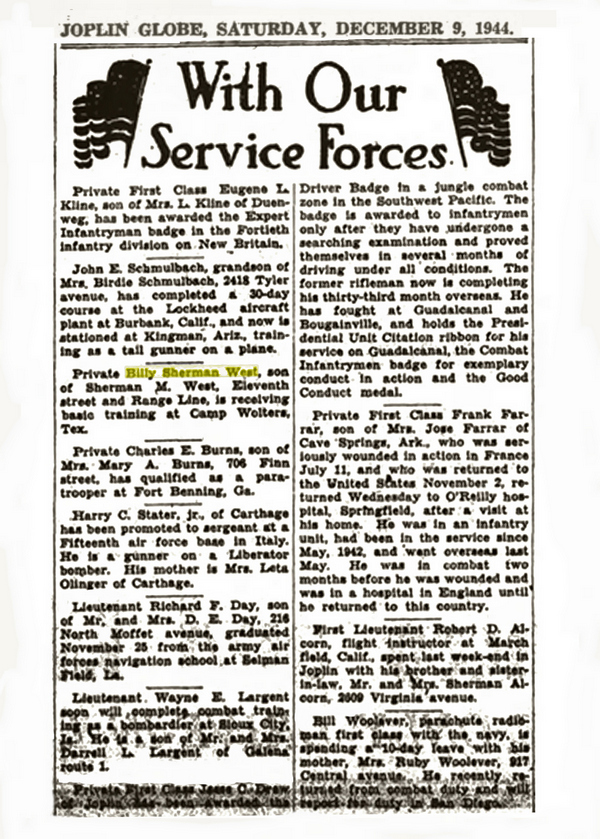 |
|
During the War, the Public Relations Office (P.R.O.) at Camp Wolters would send updates to local newspapers to let friends and family know how the home-time men and women were faring. The above article from the Joplin Globe was dated December 9th, 1944, and mentions that Private Billy S. West was receiving Basic Training at Camp Wolters. The article was printed shortly after Private West started his training which started on Nov. 28, 1944 and ended on March 10, 1945. He graduated as a trained Infantry Rifleman - part of the U.S. Infantry - the "Queen of Battle," which from 1941 had transformed from an small, ill-prepared organization to what was the best equipped and trained ground force in the war, which fought globally against the Axis forces until the final victory in August, 1945.
|
|
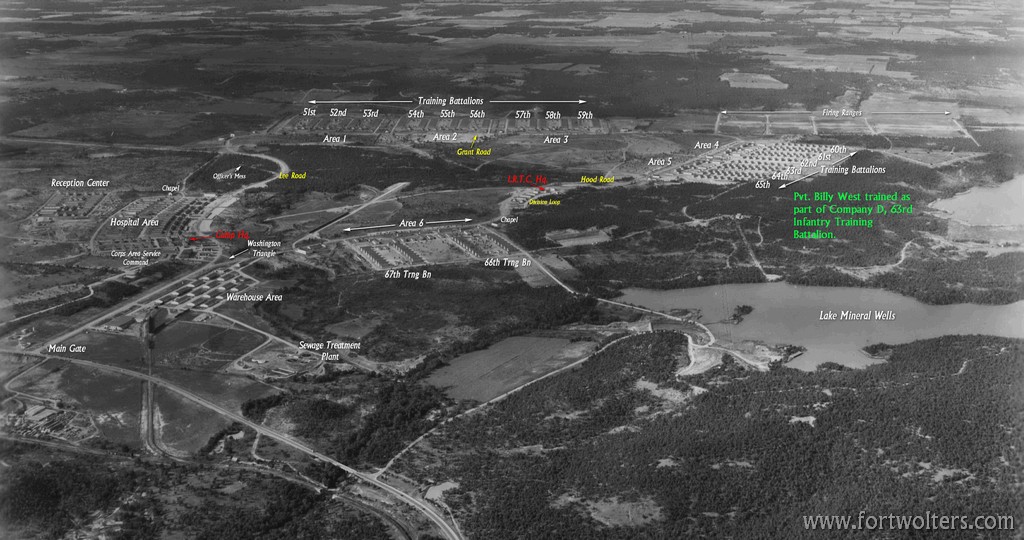 |
|
Pvt. Billy S. West took Basic Training with Company D, 63rd Infantry Training Battalion, 11th Training Regiment at Camp Wolters. The green text in the above aerial photo of Camp Wolters shows where the 63rd Training Battalion was located. Each battalion was headed by a commissioned officer (usually a Lieutenant Colonel) and was divided into four companies of approximately 250 men, each commanded by a Captain. Each company was divided into platoons, which were headed by a Lieutenant, who aided by Sergeants and Corporals were responsible for basic training in drill formations and manual of arms. The companies in each Battalion were "staggered" and started and ended Basic Training at different times. |
|
